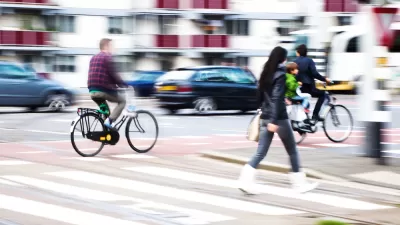The alarming rise in pedestrian deaths across the United States was predicted well before Covid-19 provided more opportunities for dangerous driving behaviors.

A new study from the AAA Foundation for Traffic Safety shows that traffic fatalities in the United States were projected to rise just as sharply even if the pandemic had not shut down roads and created conditions for faster driving, reports Kea Wilson in Streetsblog USA.
According to the study, “pre-pandemic models were already predicting a series of record years for pedestrian deaths, since they'd been trained on more than a decade of increasingly deadly data — and that prediction unfortunately, came true.”
The study finds that one likely explanation for the spike in traffic deaths during the pandemic is “a sharp increase in "aberrant driving behaviors" like speeding regardless of who else was on the road, alcohol-impaired driving, and driving without a license.”
However, principal researcher Brian Tefft cautioned that “we can't blame the roadway death crisis on a few bad-apple drivers cracking under pandemic-era stress — especially when systemic solutions exist to save lives even when motorists are driving like maniacs.” Tefft advises a safe system approach that focuses on design, infrastructure, and technology as ways to reduce risks to drivers and pedestrians. “Impaired driving prevention technology, speed limiters on cars, and speed-reducing road designs could all have curbed the bloodshed during the early days of COVID-19 — just like they could have saved lives before the pandemic and since.”
FULL STORY: Study: The Real Reasons Pedestrian Deaths Surged Along with COVID-19

Alabama: Trump Terminates Settlements for Black Communities Harmed By Raw Sewage
Trump deemed the landmark civil rights agreement “illegal DEI and environmental justice policy.”

Planetizen Federal Action Tracker
A weekly monitor of how Trump’s orders and actions are impacting planners and planning in America.

The 120 Year Old Tiny Home Villages That Sheltered San Francisco’s Earthquake Refugees
More than a century ago, San Francisco mobilized to house thousands of residents displaced by the 1906 earthquake. Could their strategy offer a model for the present?

In Both Crashes and Crime, Public Transportation is Far Safer than Driving
Contrary to popular assumptions, public transportation has far lower crash and crime rates than automobile travel. For safer communities, improve and encourage transit travel.

Report: Zoning Reforms Should Complement Nashville’s Ambitious Transit Plan
Without reform, restrictive zoning codes will limit the impact of the city’s planned transit expansion and could exclude some of the residents who depend on transit the most.

Judge Orders Release of Frozen IRA, IIJA Funding
The decision is a victory for environmental groups who charged that freezing funds for critical infrastructure and disaster response programs caused “real and irreparable harm” to communities.
Urban Design for Planners 1: Software Tools
This six-course series explores essential urban design concepts using open source software and equips planners with the tools they need to participate fully in the urban design process.
Planning for Universal Design
Learn the tools for implementing Universal Design in planning regulations.
Clanton & Associates, Inc.
Jessamine County Fiscal Court
Institute for Housing and Urban Development Studies (IHS)
City of Grandview
Harvard GSD Executive Education
Toledo-Lucas County Plan Commissions
Salt Lake City
NYU Wagner Graduate School of Public Service





























